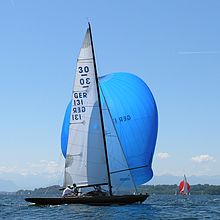30 m² skerry cruiser
30 m² archipelago cruisers are the most widespread representatives of a class of sporty sailing boats (Swedish: "skärgårdskryssare"). The number refers to the sail area of - nominally - 30 m²; they are also simply called "thirties".

Archipelago cruisers are characterized by - measured by the length of the hull - comparatively small sail area and moderate displacement , but good handling and high hull speed . However, connoisseurs particularly appreciate their timeless, elegant lines.
They were developed on the Baltic coast of Sweden in the second half of the 19th century in order to cope with the very different wind and wave conditions there. Compared to the sports boats customary at the time, the high rig also responded to light breezes in the slipstream of the archipelago , the short keel ensured maneuverability, the slim hull shape in combination with the long overhangs reduced the braking effect. At the same time, however, the effective length in the waterline and thus the hull speed increased when heeled . So sporty sailing was possible. By today's standards, the "thirties" are considered to be under rigged, due to the narrow lines they basically do not slide and the space below deck is hardly larger than that of a daysailer half as long . On the other hand, it is praised - in addition to its beauty - the steady course and the attainable altitude on the wind .
When the trend towards heavier (and therefore more expensive to purchase and operate) constructions emerged in the measurement of R-yachts in the period before the First World War , sailors in Sweden suggested using only the sail area for the division into racing classes as an alternative ; Otherwise the designers should keep a free hand to develop boats as quickly as possible ( construction class ). In 1908 the Royal Swedish Sailing Association defined and approved seven skerry classes with upwind areas from 30 to 150 m² (since 1925: nine classes from 15 m² on).
The result of the uncompromisingly simple regulation was a series of elegant and very fast racing yachts, which, however, soon reached the limits of the art of boatbuilding, as the increasingly longer, but still very narrow hulls could twist in the sea . The building regulations were fundamentally changed in 1925: if you wanted to make your yacht longer, you also had to increase speed-inhibiting parameters ( displacement as ship size , hull width, etc.). In 1920 - in Antwerp - the 30s and 40s archipelago cruisers were Olympic classes. In 1930 the measurement of the sail area was changed. Since no more significant changes were decided later, this design class was effectively "frozen" in the state of the elegant lines of the 1920s. In the Swedish Baltic Sea region in particular, the smaller archipelago cruisers - as their initiators had hoped - became a kind of “people's boat”.
After the First World War, the German sailors tried to get out of the isolation of the German Empire and increasingly relied on archipelago cruisers. In the 1930s, the English designer and publicist Uffa Fox popularized these pleasure craft in Great Britain and overseas. The influential L. Francis Herreshoff in the United States was enthusiastic about them. At the end of the 30s, around 500 of these yachts were sailing in Sweden, around 100 in Germany, around 20 in England and 25 in the USA.
After the Second World War, however, increased comfort desires of many sailors slowed the growth of the class. Because easy-care, comparatively inexpensive plastic boats with standing height, sanitary room and pantry offer more comfort with a significantly shorter length. At the end of the 1960s, however, there was a significant revival, especially on Lake Constance . The 22 archipelago cruiser is also very popular there. In 1970, a touring variant of the classic 30 m² skerry cruiser was proposed in Gothenburg; it was a success under the designation "S-30" and produced until 1979.
Since the designer still has a free hand today, ships of this class can have a length between 11 and 13 m; the width is generally around 2 m, they displace about 2–3 tons. A special feature of the measurement formula from 1930 means that a thirties can actually (legally) have an upwind sail area of 50 m².
literature
- Detlef Jens: Die Schärenkreuzer In: ders., The classic yachts. Vol. 3: Racing ships through the ages , pp. 90-101. Koehlers Verlagsgesellschaft, Hamburg 2007, ISBN 978-3-7822-0958-8 .
